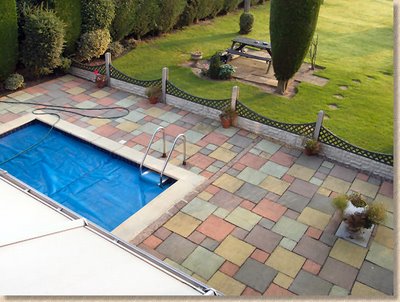Wednesday, October 22, 2008
They don't make 'em like this anymore!
While at Glee last month I stayed at Highfield Farm, a great B&B just off the M42/M6Toll junction at Curdworth, near Sutton Coldfield. It was late on the Sunday evening when I landed and after the best part of a day traipsing around the NEC, I was knackered and literally fell into the bed without taking any notice of my surroundings.
Next morning, I opened the blinds to check the weather and was greeted with this sight...

...WOW!
I thought all this old Marley paving had long since been binned, along with flock wallpaper, clackers and Showaddywaddy! Back in the 1970s, this was the ultimate in patio paving. No fancy exposed aggregates or shot-textures or stone from far-flung corners of the planet, oh no! When you wanted to impress the neighbours with your patio, the only real choice was Marley paving in a range of gaudy colours and three sizes (for some reason, the 2' x 1' size seems to be missing from this pool surround).

It is *so* of its time. I showed the picture to Denise O'Gara, now with Natural Paving but formerly marketing maestro at Marley, and we reckon it's possible to work out exactly when this patio was installed. 1973. April, probably the 18th, late in the afternoon!
In 35 years time, will we look back at an Indian sandstone patio with feature circle and immediately be transported back to 2008?
We tend not to be overly precious about historic paving. In many towns and cities throughout
Isn’t there some sort of government scheme to protect historically important constructions? Surely this should qualify as a national monument?
It's been a while
Whilst researching the move, I came across a number of 'site transfer management experts' who offered to handle the whole move on your behalf. Some were obviously students in a back bedroom, but I was very impressed with a US-based company, Websitemovers who offered excellent technical advice and what now seems like a very good price. After all the grief and stress and sleepless nights myself and my technical guru Ian went through, $200 seems like a right bloody bargain! If I ever have to move a site again, I won't hesitate to hand it over to someone like that.
The old hosting company had been a wonderful home for pavingexpert.com over the past decade, but they decided to pursue a business model that focuses on large corporate customers and they could no longer cater for smaller customers. Back in 1997 when all this started, 200Mb of webspace was gi-bloody-normous and I couldn't imagine ever needing more than around a tenth of that. Back then, most of us were on 56k copper-line dial up, so keeping images small and compressed was vital to maintain a reasonable download time. With the widespread uptake of broadband, images have been allowed to expand, in size, quality and number, but even so, it came as a bit of a shock to be told that the site was occupying a rather cumbersome 1800Mb, nine times what was allowed, but it was the bandwidth that most concerned the ex-host. With traffic over the so-called summer peaking at just short of 180,000 unique visitors per month, they wanted me to invest in one of their very expensive and phenomenally large, e-commerce enabled dedicated servers which would have pushed the running costs to well over 10 grand a year, and as the site makes no money but relies entirely on my own pocket money, that just wasn't practical!
So: a new host. It's costing more than it did, but not as much it might have done. To date, other than the transfer problems, all seems to be functioning well, the speed and uptime seem very good, and I'm playing around with some new toys that may appear over the winter, not least of which should be the new Brew Cabin discussion forum.
For now, it's good to have the blog functioning again. Let's see what goes wrong next!
Subscribe to Posts [Atom]
